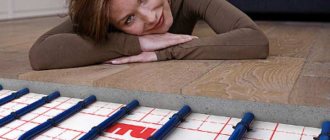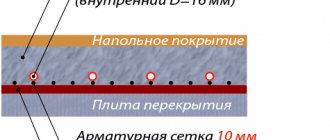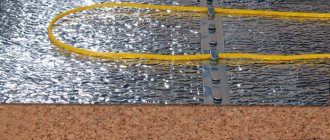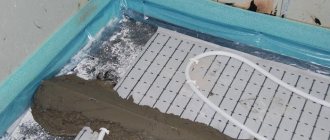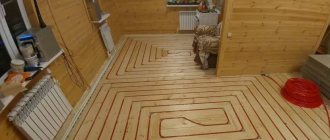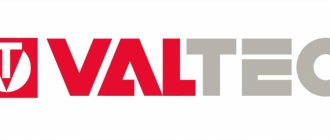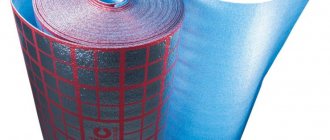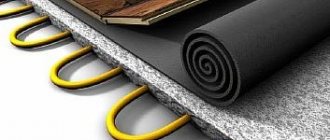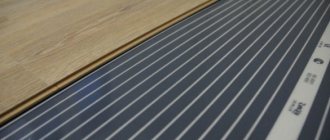Home » Equipment » Warm floor
More and more people are installing heated floors in their homes. Such a heating system does not always have to be auxiliary. Sometimes this is the only way to effectively heat an area, without unnecessary costs/complications.
So, for residents of Moscow or similar megacities, a popular option is to lay cork as a finishing coating, so to speak - cork over a heated floor. It has many advantages and disadvantages that give the chosen room comfort in every sense.
Types of lining materials
Foil polystyrene.
High heat/noise insulation characteristics, water resistance. The heat-reflecting effect is provided by a layer of foil. One of the most expensive substrates. Another foil backing for water heated floors is foamed polyethylene coated with foil. Two-millimeter thick film. Reflective effect, good heat/noise insulation characteristics. Cons: wrinkles easily, not waterproof enough. The price is the lowest.
Single-sided polyethylene: one side is foil-coated, the other is laminated with polyethylene. Thickness is 8 millimeters, waterproofing is better than the previous material, the price is higher.
Foil self-adhesive polyethylene 8 mm thick. All the necessary characteristics are in order, easy to install, and hides minor unevenness of the base well. The price is average.
In addition to foil, reflective Mylar film is used for laminating polyethylene. The thickness of such a substrate is three millimeters, and the price is higher than that of foil polyethylene. The material is valuable when laying electric floors, because... does not conduct current (unlike foil). For installation under a water floor, it has no advantages over foil pads.
Cork lining for a warm water floor. Does not crack, does not rot, and is resistant to fungal infections (unlike most wood materials). High thermal insulation and noise-absorbing characteristics, environmental friendliness. There is no thermal expansion. Not the most expensive material, since in fact it is made not from balsa wood, but from crushed oak bark.
Cork comes with or without a foil layer. In the second case, the foil is purchased separately and placed between two layers of insulation. The material is sold in slabs and rolls.
Extruded polypropylene. All the necessary characteristics are excellent, there is a foil layer. Mechanical strength, heat resistance. Sold in mats up to ten centimeters thick. The price is average.
A separate category of lining materials is a substrate for a water-heated floor with bosses. On most substrates, pipes are laid according to markings, and reinforcing mesh is used for fastening. The surface of the mats with bosses consists entirely of raised projections, between which pipes are laid.
The bosses not only mark the laying line, they also fix the pipes, preventing them from moving to the sides. Additional fixation - with clips and staples (not required for all mat models).
The mats () are made of polystyrene foam: a material with low thermal conductivity, waterproof, and a good sound insulator. If there is no foil layer, installation of reflective metal plates is necessary.
Another advantage of such mats is that they are equipped with locks for connecting to each other, which greatly simplifies the installation procedure. Minus - they are expensive compared to other materials.
Step-by-step instructions for laying cork backing
Cork substrate is produced in both sheet and roll formats. The sheets are laid according to the offset. The rolls are either rolled out and cut near the wall “after the fact” or cut into flaps in advance.
In no case do not forget about the gap of 0.8-1 centimeter, which should run around the entire perimeter: around door jambs, ledges and pipes. This is a must.
Otherwise, with a change in temperature or high humidity, the cork layer will simply swell, and the floor itself will become unusable.
Before work, restore, clean and thoroughly vacuum the base, check it for moisture. The latter is easy to do as follows: attach a piece of polyethylene to the screed using tape, or simply place an empty glass jar upside down. If condensation forms on the inside of the improvised appliances after a day, it means that the subfloor has not dried thoroughly. Those who can determine whether the floor is dry with a specialized device should know that the regulatory limit is five percent.
Then we perform the following sequence:
- We spread the polyethylene. Don't forget about the allowances on the walls. It should look like a pallet with sides of ten centimeters. Already laid strips overlap with subsequent ones with an overlap of 10-15 centimeters. We fix the film with tape, both for reliability and for ease of use;
- We roll out the first half of the cork backing, taking into account the technological indentation. Leave about a centimeter in reserve from the starting end, from the adjacent wall of the longitudinal side;
- Having rolled out the roll to the opposite wall, we cut the backing, taking into account the technological gap;
- We temporarily attach the insulating material with tape to the base in those places where it is necessary to maintain an indentation;
- We lay the laminate over the “cork” strip.
Briefly about the use of heated floors and its varieties
Distribution comb for heated floors - purpose, types, installation
The most common class is water heated floors. They can be mounted directly inside concrete screeds and are reliable and durable. Insulation under warm flooring of this class can be made from a wide range of materials. There is also a choice of options for constructing the surface for laying.
Water heated floors have an impressive list of advantages:
- There are heating boilers for sale on the mass market using different types of fuel, in which the connection of a heated floor is provided for by the design;
- solutions proven over the years are used for installation;
- the proposed pipe installation options provide trouble-free operation times of 10-15 years;
- the base for a heated floor can be constructed using different methods;
- heat transfer is controlled and uniform over the entire installation area.
The only disadvantage of water-type heated floors is the installation restrictions in apartments. They are prohibited from being connected to centralized heating systems, since it becomes impossible to track the total heat consumption, and also, if the systems are installed on a mass scale, the heating stations may not be able to withstand the load.
A universal, but relatively expensive to operate, floor heating system is electric. It is based on the use of film heaters or cables laid under thin finishing coatings. The advantages of electric heated floors include simplicity and the possibility of installation inside the apartment. However, it is worth especially noting that the base for laying film heaters must be prepared very carefully.
The underlay for electric-type underfloor heating is selected taking into account additional criteria. Electrical conductivity and the ability to retain moisture play a big role; both factors can lead to both short circuits and the occurrence of parasitic leakage currents, which increase the cost of paying for consumed energy.
How to install a heated floor under a cork?
More and more people are installing heated floors in their homes. Such a heating system does not always have to be auxiliary. Sometimes this is the only way to effectively heat a room without unnecessary costs/difficulties.
So for residents of Moscow or similar megacities, a popular option is to lay cork as an overcoat, like a cork on a warm floor. It has many advantages and disadvantages that give the selected room comfort in every sense.
Choosing material
Mats for warm water floors
When choosing such a material, you must follow certain criteria
There are several important points that you should also pay attention to, for example, the thickness and quality of the installed substrate.
The material must have the following properties:
- high level of resistance to mechanical and temperature deformation;
- corresponding indicator of thermal insulation and waterproofing materials;
- the material used must be classified as environmentally friendly and at the same time safe;
- use should be convenient and simple. This will save your own time and effort during installation work;
- the material must have heat-reflecting properties;
- must have excellent soundproofing characteristics;
- the material must be able to withstand any, even the most drastic, temperature changes.
A foil surface material can be used on the floor. For installation of a warm water floor, it is the most optimal and a high-quality substrate is made.
The most popular types of substrates are:
- Tuplex products. This thickness is no more than 2.5 mm, while they are characterized by the presence of excellent heat-reflecting characteristics and waterproofing properties.
- High performance characteristics.
- Foil self-adhesive fabric. The thickness is about 7.5 mm. Use on difficult surfaces. It has a high heat transfer rate and waterproofing properties. It is worth considering the presence of soundproofing properties.
- PPS foil. It can be sold in different thicknesses, and the higher the indicator, the better thermal insulation qualities the material has. Has reflective ability.
- PE one-sided laminated. The undeniable advantages include a very small thickness (less than a centimeter), with high thermal insulation and waterproof characteristics.
- Foamed PE. With a very insignificant thickness, only 2 mm, it has truly excellent characteristics, including waterproofing and thermal insulation.
Disadvantages and customer reviews
The first thing that needs to be said about the most important and most significant drawback is the high cost. The price depends on the thickness and type of specific coating.
Buyers often complain that despite sufficiently high performance and high resistance to mechanical stress, traces of furniture remain on cork floors. It's nothing you can do.
In addition, users of such floors noted that over time the protective layer wears off from the surface. This is especially noticeable in rooms where people often walk. The “beaten” path is clearly visible. This just goes to show that your cork floor needs to be taken care of.
Substrate requirements
How to install a mixing unit for a heated floor with your own hands
It is worth approaching the selection of a suitable underlay for a heated floor in terms of service life and the cost of its installation.
Each system has its own requirements, among which it is customary to highlight:
- Thermal insulation. The lower the thermal conductivity of the material, the more suitable the underfloor heating is considered. As a rule, better thermal insulation properties are achieved due to a greater thickness of the substrate. However, this does not work in all rooms. Because it is not always possible to further raise the floor level. In this case, you have to put in thinner options. On the positive side, samples made of foamed polymers with a heat-reflecting coating showed themselves.
- Resistance to loads. It was previously noted that a warm floor consists of several layers. The substrate, as the lowest one, bears the weight of the rest of the structure, as well as the load when walking. Constant pressure leads to compression over time. This is more typical for porous materials. In deformed areas of the lining, thermal conductivity increases and, accordingly, the efficiency of the entire system decreases. In this case, materials with a higher density are preferable.
- Waterproofing. This criterion is important for a water floor system. Leakage is equally harmful to both concrete and wooden foundations. And the neighbors below will not be happy with such a gift. Detecting leaks in pipes with waterproofing is more difficult, but possible. In this case, the indicator is a drop in water pressure. For a classic electric floor system, waterproofing is not so important, since the cables and heating mats have their own. But infrared film floors absolutely cannot tolerate moisture, so complete insulation is necessary both from below and from above.
- Manufacturability. This characteristic means ease of installation of the substrate. Let's compare a few examples:
- Foamed polystyrene is very easy to install. It is thin, flexible, easy to cut with scissors, and sold in compact rolls. It is a pleasure to work with it, if you forget about the big disadvantage - deformation under load.
- Extruded polystyrene foam in rolls is a strip of rectangular segments connected by foil film. It is more difficult to cut due to its thickness, and the seams need to be sealed. All the inconveniences are covered by a big plus - it is an excellent insulation. And the high density of the material prolongs its performance. (Fig. 2)
- Extruded polystyrene foam in sheets is easier to lay, but more seams will have to be sealed.
In fact, all three options are made of the same material, but the form of delivery determines their manufacturability.
- Environmental friendliness. Each of the synthetic linings releases toxic substances to varying degrees when heated. Naturally, the less evaporation, the better, especially for residential premises.
- Resistance to biological influences is completely absent in substrates made from natural materials. Antibacterial impregnation helps save the situation a little. However, it is not recommended to use it as insulation.
- Sound insulation is generally a big plus (for apartment buildings), but it does not matter for the functionality of the heated floor.
- Resistance to high temperatures - allows you to mount heating elements directly on the film. There are samples on the market that can withstand up to plus 90 degrees Celsius.
- Additional qualities. The products of some manufacturers come with markings or bosses (bulges), which help to quickly and evenly install heating elements (pipes, wires).
A few words about ultraviolet resistance.
The presence of this criterion in the list of characteristics of the underfloor heating substrate is nothing more than a marketing ploy, since it will in no way be exposed to direct ultraviolet radiation.
Advantages and disadvantages
As mentioned above, a substrate with a foil surface is an excellent material for saving energy. In addition, foil has a number of other advantages, but there are also disadvantages.
| pros | Minuses |
| Does not affect the height of the floor, since the foil material is only 2-10 mm thick. | High cost is the main disadvantage. |
| It is not difficult to install, so even an inexperienced person can handle the job. | It is not recommended to use a mineral substrate with a metallized layer for heated floors, since toxic substances are released during the heating process. |
| It has soundproofing and waterproofing properties. | Using such a substrate in rooms with high humidity significantly reduces its service life. A foil-coated product is recommended. |
| Withstands heating up to +90 degrees and more. | Dissolves upon direct contact with cement. |
| Most products with foil are equipped with markings, which simplifies the process of laying heating elements. | |
| There are models with a sticky layer, this makes installation easier. | |
| Reduces heat loss and promotes its uniform distribution. |
It should be noted that the foil product is strong and durable if installed and used correctly.
What type of substrate should be used for the water system?
The main condition for a heated floor system is to ensure an increased degree of heat transfer. In this case, heat will not be wasted. Provided that the floor is based on pipes, the underlay in the event of an accident will perform an additional waterproofing function.
Sometimes you can use a special molded foam cover that is very easy to secure the pipeline into. The same coating acts as a substrate
Typically, a typical base for the substrate is foil, which helps to reflect heat, which should not go to heating the ceilings of the neighbors below. If the foil is sufficiently thick, it can be in its pure form or on a polymer base (glued in a thin layer). In principle, the heat insulator has a low degree of waterproofing. This protection must be ensured by laying a separate layer of insulating material.
The substrate does not need special fastening, since it is laid on the insulation. When installing a water heated floor, a reinforcing screed is used, which presses down the substrate
The main difference when comparing identical underlayment models is the cost and different service life. And the modern market offer does not yet offer a wide range.
Installation
You should start by preparing the base. There should be no flaws, unevenness, debris or other similar difficulties. The panels themselves are brought into the room a week before installation. They gradually warm up, reaching the desired level of acclimatization. That is, they are prepared for installation.
Fastening with glue involves gradually filling the area from the center of the room. There, in 100% of cases the surface is dry. As it fills, the heat dries out the corners. The method always works.
The adhesive mixture must be applied to the base and boards. Installation is carried out parallel to long walls. First, half the room is filled. Interlocking panels are easy to install even without a cork floor heating system.
By improving the final quality we mean the polyurethane base. The process starts from windows to doors. The parts are connected at an angle of 30 degrees. Detailed instructions are included. It is allowed to hit with a rubber hammer.
We recommend: How are PEX pipes connected for heated floors? There should be empty space along the walls. The distance is no more than 1 cm. The ideal option is 8 mm. After heating/humidity, slight deformation will occur. The remaining space will be filled. This is the right choice and ensures reliable fixation.
Types and characteristics of the substrate
So, when buying thermal insulating flooring, you first of all need to navigate its variety of types:
- Lavsan is a film-based coating (foamed polyethylene) with a metallized reflective top layer. Characterized by resistance to aggressive environments. A lavsan underlay for a heated film floor fits perfectly.
The photo shows the laid lavsan.
Note! This type of insulation is characterized by a certain power density. Therefore, the choice must be made taking into account the finishing coating
So, when installed under tiles, the power of lavsan is 220 W per m²; under laminate/parquet – 150W per m²; under carpet/linoleum – 220W per m². If you lay a film with a higher UV value than specified, the floor covering may deteriorate due to overheating.
- Expanded polystyrene is a cellular insulation material. It has a high temperature threshold: from -180° to +180°, and is wrinkle-resistant. It is an excellent sound insulator and has increased resistance to bacteriological influences. Has a foil or polypropylene coating. It is considered an excellent option for underlayment for water heated floors.
Expanded polystyrene boards.
A distinctive feature of this heat insulator is that it is produced in slabs with ready-made markings (50 to 50), which greatly simplifies the subsequent process of installing the floor. Slabs with different thicknesses are available for sale: from 20 to 50 mm.
- Technical cork, cork backing. It is environmentally friendly and therefore hypoallergenic. Its composition is compressed cork oak bark + astringent substance – suberin. Not eaten by rodents. As a rule, cork is used as a substrate for laminate flooring.
Despite this composition, the insulation is not flammable and shows excellent resistance to mechanical stress. It is optimal for arranging a water floor.
Cork backing in sheets.
- Polypropylene (penofol). Combined insulation, consists of foamed polyethylene. One side of it is covered with foil. Thanks to this structure, polypropylene has high heat retention properties. It is somewhat inferior to its cork counterpart in terms of its qualities. This foil backing for underfloor heating is practical and durable.
Polypropylene insulation.
Note! The substrate should not contain aluminum, since it is an excellent conductor of electricity. Therefore, if the contacts are defective, a short circuit is possible.
Functions of insulating flooring
If you are wondering whether an underlay is needed for an infrared heated floor, then you should pay attention to the following functions of the flooring:
- The main task is to reduce heat loss. The substrate directs IR rays into the room, preventing them from spreading to the lower floors or basement of the building. Due to this reflection, heat is not wasted, and the efficiency of the system corresponds to 95-100%. The use of such insulation can reduce heat loss by an average of 20-30%.
- As mentioned above, the underlay acts as a waterproofing layer, protecting the flooring from steam and moisture.
- It is capable of leveling out minor surface imperfections, which is very important when using film-type floors.
- High-quality insulation, for example, Valtec underfloor heating, can significantly reduce the amount of noise. It is made of foamed polystyrene and has a foil side.
Film floor installation.
Note! Fiberboard slabs can be used as a bedding for coverings that require a solid base (support for a tile covering, for example).
How to choose a quality product
The main criterion for choosing this material is not the price, but the technical characteristics, which should be based on two criteria:
- Finish coating. For example, if you plan to lay laminate flooring, then you should choose a soft underlay, as it perfectly levels the base. For linoleum, it is recommended to choose solid thermal insulation, since this coating is a soft material, and therefore, together with soft insulation, it can easily be pressed through by furniture legs.
- Levelness of the floor. If you are dealing with a coating characterized by significant level differences, then you should choose soft thermal insulation, since it is more flexible. If the unevenness is small, then it is better to choose a more rigid flooring.
Subspecies
Popular ones are:
- algomerate;
- veneer;
- a combined coating of the above proposed elements.
In the first case, the crumbs are compressed at high temperature. The price is affordable for most buyers. The second implies uniform sheets.
They are extracted directly from natural wood. The number of shades excites the imagination. The high cost is due to numerous advantages.
According to the installation method, cork flooring for heated floors is divided into:
- adhesive panels. The material consists of 100% wood. It is secured using construction adhesive. Standard thickness is from 4 to 6 mm. Afterwards it is covered with a double layer of varnish. Does not absorb moisture. The base must be equally level over the entire plane.
- glueless. Reminds me of laminate. The structure is made of a protective layer with agglomerate, MDF sheet, and cork backing. There is a decorative pattern/element at the top. The lower part insulates from noise and prevents harmful bacteria. A popular option for children's rooms.
In fact, each of the subspecies is worthy of attention. Their use is determined by the specific preferences of people. Which, in turn, consist of small nuances/subtleties.
Underlay for infrared heated floors
For the high-quality functioning of infrared underfloor heating, two recommendations must be followed:
- strict adherence to installation technology;
- installation of heat-reflecting material with foil facing up.
When laying a reflective layer under a heated floor, it is recommended to follow the following advice from professional craftsmen:
- Magnesite boards and particle boards. Before installing such material, an aluminum film is laid on the base, and a substrate is laid on top. For these purposes, foil layers can be used.
- Metallized polymer-based materials are mounted with the smooth side up. As a result of this installation, a thin and effective heat-reflecting coating is formed.
- The layer is laid over the entire floor surface on which the heating system will be installed. The material is laid overlapping, firmly gluing the joints with special tape. Such measures will create sufficient indicators of hydro- and thermal insulation. The adhesive tape for the backing must be metallized. Ordinary materials may not withstand heat and melt.
By following these simple rules, you can easily install and select a high-quality substrate yourself. Be sure to consider the composition of the material and its compatibility with your heating system.
There are reflectors that can greatly facilitate the process of installing electrical cables. These are the so-called layers with bosses. The design of such material is a carpet dotted with dense rows of protruding cylinders. These projections are called bosses. It is very convenient to lay the underfloor heating cable between them. This installation does not require additional fasteners or adhesives - the bosses firmly hold the cable on the surface of the interlayer, preventing them from moving to the side.
Metallized film based on natural lavsan
Modern material, used for all types of heated floors. Does not tear, withstands great breaking forces. Can be used on uneven surfaces - speeds up and simplifies the process of installing underfloor heating with water heating. Does not burn, retains original factory characteristics for a long time. Disadvantage: it is afraid of water and needs reliable and functional water protection.
Metallized lavsan film
foil backing
Which is the best underlay for laminate? Corporate approach
Tuplex branded underlay may be the ideal solution to the issue of choosing underlay for laminate flooring. It has a thickness of 3 mm, is made in the form of two layers of film, the internal space between which is filled with granulated polystyrene. It removes moisture well, protects against the formation of fungus, and is convenient to use, but its price encourages you to choose similar materials from other manufacturers.
Also easy to use, the backing for polystyrene laminate is produced in the form of small sheets measuring 60x120 cm and is in no way inferior in quality to its cork counterparts. Moreover, polystyrene better smoothes out unevenness of the screed, can even be laid on top of wooden floors, has a high noise absorption coefficient, promotes thermal insulation, but... is short-lived compared to cork. Over time, it loses its elasticity and after 6-10 years it becomes useless in terms of supporting the laminate. In addition, polystyrene is very dangerous when burned; it emits abundantly caustic and poisonous smoke.
Polystyrene laminate backing photo
There are cases when laminate is laid on top, where, in principle, there cannot be any moisture, however, a lining is needed. The underfloor heating for laminate flooring must conduct heat, so cork and polystyrene will be ineffective. There is a special underlay for arbiton heated floors; its perforated (small hole) sheet allows heat to pass through freely, while also performing its main function - supporting the laminate.
It is also possible to use a polyethylene backing without foil; in extreme cases, you can simply lay corrugated cardboard; on a warm floor, where there is no moisture at all, this method also works. Since laminate itself conducts heat very poorly, it is necessary to use samples specially made for heated floors.
As you can see, the choice of underlays for popular flooring is wide, so it is difficult to say which underlay is best for laminate; it is better to listen to what laminate manufacturers say and choose the type of underlay that they recommend.
The most suitable cork underlay thickness and priority installation methods
Laminate is a very convenient flooring option. It looks amazing, lasts a long time and is inexpensive. It is easy to install and easy to care for. In general, there are a lot of advantages. But in order for a freshly made floor to really have high technical characteristics, it needs to be selected with a high-quality underlay.
What is it for?
- Eliminates minor unevenness of the base;
- Increases the thermal insulation value of the floor;
- Absorbs sounds while moving;
- Reduces shock and static loads.
All this has already been discussed in this article, but repetition, as they say, is the mother of learning.
The cost of the cork substrate clearly hints that in combination with it it is wiser to use laminate from expensive brands, the thickness of the boards of which starts from eight millimeters. The last parameter directly affects the choice of “gasket”.
If the thickness of the board is eight millimeters, then the thickness of the lining can be 2 mm. Under a thicker coating, a substrate of three millimeters will do. PolaRemont.ru does not recommend exceeding the above limits, even if you are using heavy-duty commercial grade laminate flooring. So, when moving across the floor, the thick substrate will spring back, which will lead to play and breakage of the locking system.
Due to constant exposure to the floor, the underlay is wrinkled in some places. Often it is reduced by half. As a result, a vertical play of one or two millimeters is formed. Since, according to building codes, differences of two millimeters are allowed on the base, the total play in some places reaches 4 mm.
Yes, the slats have good rigidity. This is why external load forces them to break. Therefore, the greater the thickness of the substrate, the greater the backlash. As a result, the locks break. Notch, as a golden rule - the thickness of the substrate should vary from two to four millimeters.
The direction of laying the gasket is a question to which there is no clear answer.
There is an opinion that the underlay should be laid along the direction of the boards. But if the manufacturer’s instructions confirm the use of this particular scheme, then follow it. The fact that the longitudinal method is advantageous is confirmed by the minimized number of incisions. Plus, it’s much more convenient to work with, since the underlay is not laid on the entire floor at once, but in strips immediately on the area that you plan to cover with laminate in the coming hours.
However, there is also a technical justification for the transverse type of flooring: the line of connection of the boards and the joints of the substrate will probably not coincide. Therefore, in order to maintain the integrity of the locks, it is better to use transverse laying.
Adviсe
One of the most modern trends in solving the issue of thermal insulation at home has been the installation of a “warm floor” system. Nowadays, manufacturers have brought to the market three main options for underfloor heating - water, infrared and cable. The water method is used for large areas. This technique involves circulating hot water through pipes built into the floor. Such a system has a number of limitations:
- it cannot be used in multi-storey buildings, as it creates additional pressure on the floors;
- in the event of a breakthrough, there is still a risk of “flooding” the neighbors below, which will lead to large expenses for troubleshooting;
- high cost of materials, as well as installation work.
The infrared floor is a polymer film, which is divided into identical squares, each of which contains special plates responsible for high-quality heating.
It is better to install such a system under laminate or linoleum. If you use it under tiles, it bonds quite quickly with the adhesive solution.
Cable is an electric floor that can function year-round. In order to reduce energy costs, special thermostats are built into the design. The structure itself is assembled from two- or three-core cables or electrical mats.
This method is optimal for tiles, as it helps them heat up quickly and retain heat.
The “floating floor” technology is very popular; Isover coating is used for it.
Benefits of cork
Cork has a lot of advantages not only as a building material, but also in itself.
Among the main positive qualities of cork are the following:
- environmental friendliness;
- good thermal insulation properties;
- low cost;
- soundproofing qualities;
- fire resistance;
- excellent rot resistance;
- hypoallergenic;
- Possibility of individual color selection.
In addition, cork floor insulation is soft, prevents feet from slipping and does not absorb odors. For these qualities, cork is especially valued when arranging children's rooms.
What kind of substrate to lay under a warm electric floor
So, you can install a “floating floor” system.
The floor must be reliably hydro- and vapor-insulated; for this, the joints of the panels must be glued with aluminum tape.
After installing the heating elements, you can begin laying the reinforcing mesh, only then can you begin arranging the screed. After the filling has been completed, the edges of the insulation should be carefully trimmed. Afterwards, the floor will have to warm up for quite some time, then it can be put into operation.
Insulation of surfaces with penofol provides hydro-, heat- and noise insulation, reducing the level of impact noise by 20 dB, which guarantees uniform heating due to the reflective properties of penofol.
Before insulating a floor using penofol, you should familiarize yourself with the installation features of one or another type of insulation of this class, since incorrect installation technology can cause ineffective thermal insulation.
Electrical
Heating occurs due to the energy released by conductors under the influence of electric current.
By design, heated floors of this type are film, that is, infrared, and cable, which have a heating element in the form of simple flexible cables with conductive elements inside. During the installation of electric floors, complications may arise, so you should take into account all the parameters of the existing wiring in advance, as well as correctly calculate the protective fittings.
For heating to be effective, the design power per 1 m2 must be at least 0.25 kW. It is very important when installing a heated floor that the correct underlay for the heated floor is selected. There are a large variety of substrates, and each of them is designed to perform specific functions.
Choosing the type of installation of water systems for flooring laminated boards
It is most rational to install such a warm floor in a private cottage. Water heated floor under laminate –
This is a structure made of pipes laid under a covering of laminated panels. Hot water moving through the system heats the concrete screed and the finishing surface of the floor.
Warm water constantly circulates through the metal-plastic pipes of this system, heating the finishing floor covering
It would not be out of place to add that modern floor heating systems are made from innovative materials. Metal-plastic and polyethylene structures are reliably protected from leaks and serve no worse than traditional copper pipes, and their cost is much lower.
Installation of a water heating system under a laminated coating has certain nuances, since the lamellas do not conduct heat well enough. You should also know that not all methods of laying this thermal system are suitable for such a floor surface. Thus, when installing water heating pipes in a flat manner, the floor heating effect will tend to zero. Therefore, the best option would be to lay the heating system in a layer of cement screed.
Professionals say that it is best to install warm water floors under laminate using the concrete method.
Thus, the layer of solution will protect the pipes from mechanical damage. In addition, the screed will warm up completely, which will allow heat to be transferred evenly.
To install the heating structure correctly, you need to take into account some details. Work begins by dividing the floor surface into segments and determining the location of the heating elements. Next, the plane is leveled, a layer of thermal insulation is laid, and reinforcement for the concrete screed is secured. Afterwards the mounting rail is attached and the underfloor heating pipes are laid. They are fixed with wire to the cells of the already laid metal base. The reinforcement mesh acts as a marking for the installation of a floor heating system.
Pipes can be laid in any of two known ways - parallel or in a spiral, depending on the previously drawn up project.
To lay laminate flooring over a heated floor, experts advise filling the heating system with cement mortar
The next step is to fill the installed system with concrete to form a screed. After final polymerization of the solution, a test run of the system should be carried out. It is necessary to check the pressure in the pipes and adjust the temperature. If the design works effectively, it can be considered ready for use.
Proper care of cork flooring
Heated cork flooring is a heating system with its own nuances. One of these is proper maintenance after use. The performance of the material directly depends on it. Even sudden movement of furniture reduces them. It is better to glue special rubber bands or felt on the legs.
Then the decorative layer will not be subject to mechanical damage. Cleaning only with a soft damp cloth. Vacuum cleaner with brushes. No abrasive surfaces or hard metal materials.
The average service life is 10-15 years of use. But it depends on observing many subtleties. Some consider this to be a serious disadvantage.
At the same time, forgetting about the huge number of advantages. Cork covering for heated floors is sometimes difficult to replace with anything. Especially after some use.
- Related Posts
- How does the underfloor heating calculator work?
- What kind of warm floor to lay under a parquet board?
- Which plasticizer to choose for heated floors?
- What is film heated flooring?
- What concrete is suitable for a warm water floor?
- How is xl pipe heated floor installed?
Stability of characteristics
Groups of porous materials, such as polyethylene foam and expanded polystyrene, have an unpleasant feature. Over time, under the influence of static stress (burden from lying pipes and the load when walking on the floor) they are compressed. The thickness of the substrate decreases, the process may proceed unevenly, differing in different areas of the room. This can cause unpleasant consequences.
You need to select a substrate material based on the service life and physical characteristics declared by the manufacturer. Temporary changes in geometry are taken into account, as well as production technology. For example, expanded polystyrene foam has an open structure and sticks together over time. At the same time, extruded has completely closed cells, is elastic, retains its geometry and properties for decades.
